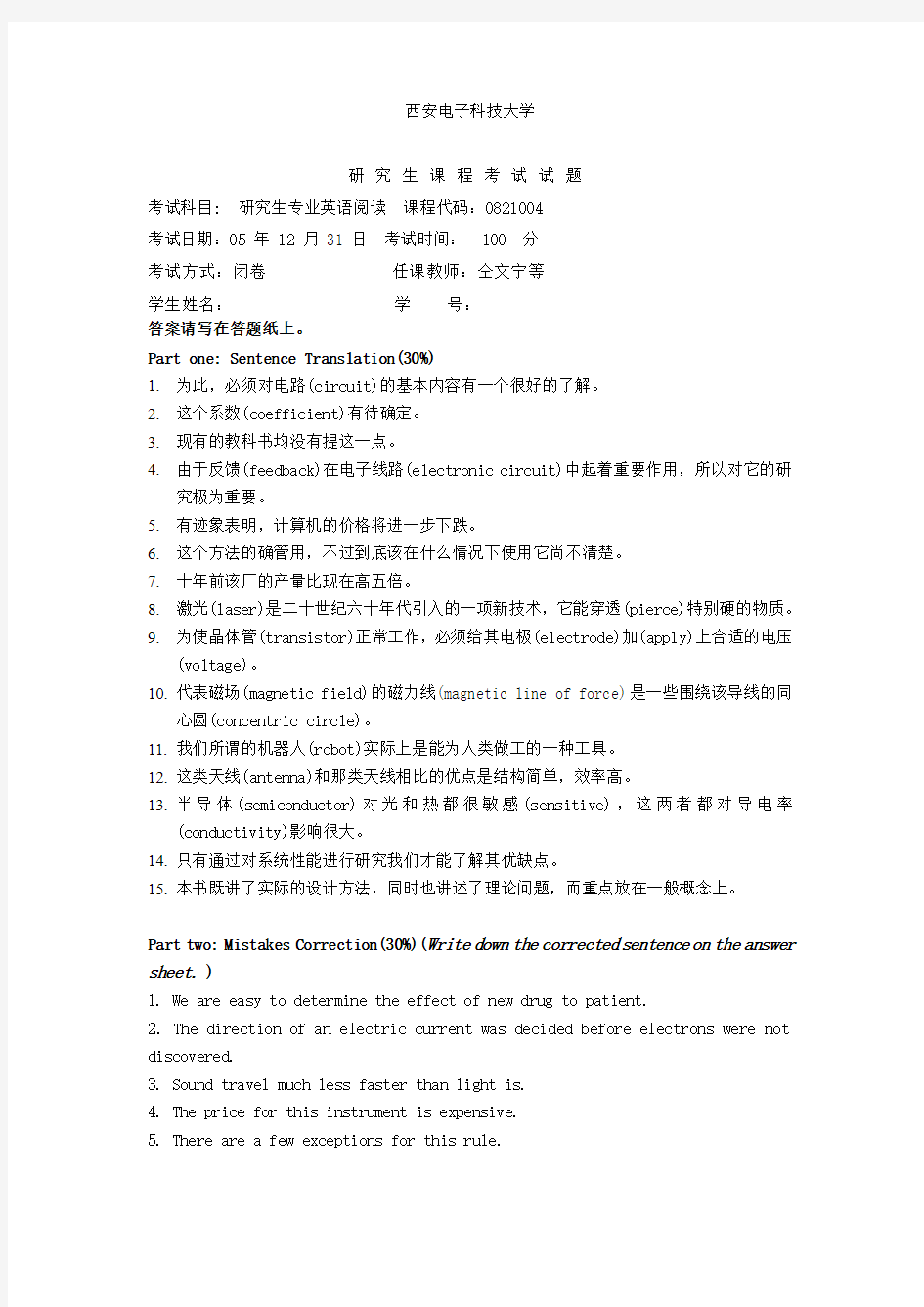2005下学期专业英语阅读

- 1、下载文档前请自行甄别文档内容的完整性,平台不提供额外的编辑、内容补充、找答案等附加服务。
- 2、"仅部分预览"的文档,不可在线预览部分如存在完整性等问题,可反馈申请退款(可完整预览的文档不适用该条件!)。
- 3、如文档侵犯您的权益,请联系客服反馈,我们会尽快为您处理(人工客服工作时间:9:00-18:30)。
西安电子科技大学
研究生课程考试试题
考试科目: 研究生专业英语阅读课程代码:0821004
考试日期:05 年 12 月 31 日考试时间: 100 分
考试方式:闭卷任课教师:仝文宁等
学生姓名:学号:
答案请写在答题纸上。
Part one: Sentence Translation(30%)
1.为此,必须对电路(circuit)的基本内容有一个很好的了解。
2.这个系数(coefficient)有待确定。
3.现有的教科书均没有提这一点。
4.由于反馈(feedback)在电子线路(electronic circuit)中起着重要作用,所以对它的研
究极为重要。
5.有迹象表明,计算机的价格将进一步下跌。
6.这个方法的确管用,不过到底该在什么情况下使用它尚不清楚。
7.十年前该厂的产量比现在高五倍。
8.激光(laser)是二十世纪六十年代引入的一项新技术,它能穿透(pierce)特别硬的物质。
9.为使晶体管(transistor)正常工作,必须给其电极(electrode)加(apply)上合适的电压
(voltage)。
10.代表磁场(magnetic field)的磁力线(magnetic line of force)是一些围绕该导线的同
心圆(concentric circle)。
11.我们所谓的机器人(robot)实际上是能为人类做工的一种工具。
12.这类天线(antenna)和那类天线相比的优点是结构简单,效率高。
13.半导体(semiconductor)对光和热都很敏感(sensitive),这两者都对导电率
(conductivity)影响很大。
14.只有通过对系统性能进行研究我们才能了解其优缺点。
15.本书既讲了实际的设计方法,同时也讲述了理论问题,而重点放在一般概念上。
Part two: Mistakes Correction(30%)(Write down the corrected sentence on the answer sheet. )
1. We are easy to determine the effect of new drug to patient.
2. The direction of an electric current was decided before electrons were not discovered.
3. Sound travel much less faster than light is.
4. The price for this instrument is expensive.
5. There are a few exceptions for this rule.
6. The hotter the body will be, the more it radiates energy.
7. The feature of this device is small in size and light in weight.
8. That professor is very interesting in this topic.
9. Our semiconductor industry comes into being at the end of 1950s.
10. The both engineers are busy to design a type of new computer.
11. Work equals to force multiplying distance.
12. The new design instrument is in good quality.
13. The ability for some elements to give off radiations is referred as the radioactivity.
Part three:Read this article, translate the underlined sentences(15%), answer the questions (15%)and then summarize this article within 100 words (10%).
The Dazzle of Lasers(激光)
The acronym(首字母缩写词)"laser," describes how the device works: Light Amplification by Stimulated Emission of Radiation. In 1916 Einstein predicted that electrons(电子) in an atom could be deliberately stimulated to emit photons(光子) (light energy) of a certain wavelength. He was right. The laser must first be "pumped" with energy in a variety of ways so that the electrons are excited into higher energy states. But these high energy electrons are unstable--and fall back to a lower energy level. On the way down, their extra energy is released(释放)as light. That light is captured inside the laser and amplified by bouncing it back and forth between mirrors. The laser beam that emerges is amplified, monochromatic (单色的), coherent light --and it shines with an unearthly power.
Not until 1960 did Theodore Maiman, a 33-year-old engineer at Hughes Research Laboratories, build a homely four-inch cylinder containing a ruby rod encircled by a flash tube: the world's first working laser.
More than two decades later, the laser has wrought a technological revolution. Lasers are an indispensable tool for delicate eye surgery, and doctors are using lasers experimentally to destroy cancerous tumors(肿瘤), unclog(使畅通) diseased arteries (动脉) and even treat herpes(疱疹). Just as they provide new tools for health care, however, they also make possible new engines of destruction: recently Dr. Edward Teller, the father of the hydrogen bomb(氢弹), called on President Reagon to urge that the United States build a space-based laser-weapon system that would use a nuclear bomb to fire brutally intense laser X-rays against enemy missiles in
